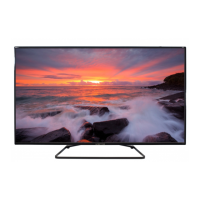Why I cannot change the time manually on my Sceptre HDTV?
- TTerry HowellSep 1, 2025
Your Sceptre HDTV automatically syncs the time according to your local TV channel, but only when the display’s tuner is connected to an antenna.

Why I cannot change the time manually on my Sceptre HDTV?
Your Sceptre HDTV automatically syncs the time according to your local TV channel, but only when the display’s tuner is connected to an antenna.
Why is there a big black box in the middle of my Sceptre HDTV screen?
The black box on your Sceptre HDTV screen indicates that closed captioning is turned on and set to TEXT1 – TEXT4. Change the setting to CC1 or turn off closed captioning to remove the box.
Why does switching a channel or source change the volume on my Sceptre HDTV?
Volume fluctuations when switching channels or sources on your Sceptre HDTV occur because different channel signals have varying loudness levels. To mitigate this, enable the AUTO VOLUME LEVEL function on your display.
Why is there noise or trash pixels on the screen of my Sceptre HDTV?
Noise or trash pixels on your Sceptre HDTV screen appear when your display’s resolution is higher than the digital channel’s broadcast resolution. The signal is up-converted to match your display’s resolution.
Why does my Sceptre HDTV turn off automatically after 10 minutes?
Your Sceptre HDTV has a power saving mode that automatically turns off the display if no signal is detected for more than 10 minutes.
Why is my Sceptre HDTV picture very dim?
If your Sceptre HDTV picture is very dim, check if you are in POWER SAVING mode. Press the PICTURE button on the remote control to switch out of POWER SAVING mode.
| Screen Size | 50 inches |
|---|---|
| Resolution | 3840 x 2160 (4K UHD) |
| Display Type | LED |
| Refresh Rate | 60Hz |
| USB Ports | 1 |
| HDR | Yes |
| Audio Output | 2 x 10W speakers |
Covers risks of fire, electric shock, moisture, and provides product placement/handling advice.
Lists essential instructions for safe installation, operation, and cleaning of the product.
Covers safe plug usage, power cord protection, and avoiding water exposure.
Guides on using specified accessories, moving the unit, and seeking qualified service for damage.
Details power switching, cleaning, accessory use, and maintaining distance from heat sources.
Explains power source types, grounded plugs, and avoiding overloading extension cords.
Discusses wall socket accessibility, power sources, thunderstorms, and moisture avoidance.
Warns against self-repair, handling damaged units, and proper battery insertion.
Covers reading the manual, using correct power cords, flat surface installation, and ventilation.
Step-by-step guide to attach the L and R display stands using screws.
Details on attaching L and R stands for U55 and U65 models.
Details the functions of VOL +/-, CH +/-, Menu, Source, and Power buttons on the display's side.
Explains SPDIF, YPbPr/AV, and Line Out connections for audio and video input.
Details HDMI 4, 3, and 2 connections, including version, resolution, and refresh rate support.
Describes HDMI 1 (ver. 2.0/MHL) for 4K, ARC, CEC, and mobile device connectivity.
Shows the SCEPTRE remote control with labeled buttons like Power, Source, Mute, Navigation, etc.
Details functions of POWER, SOURCE, CC, MTS, MUTE, Number buttons, GUIDE, INFO, Menu, Exit, Aspect, Freeze, Sleep, CH, Favorite, Picture, Sound, USB.
Provides instructions for inserting two AAA batteries, matching polarity.
Guides connecting to digital cable or antenna without a set-top box, including initial setup steps.
Step-by-step guide for connecting a DVD player using Component (YPbPr) and RCA audio cables.
Guides on connecting cable or satellite boxes using an HDMI cable and switching to HDMI source.
Instructions for connecting a PC via HDMI 2.0 to HDMI 1 port, setting PC resolution to 3840x2160.
Guides on connecting a digital audio receiver using an optical SPDIF cable.
Explains how remote buttons (Menu, Exit, directional, ENTER) navigate the OSD menus.
Introduces the main OSD categories: PICTURE, SOUND, CHANNEL, and SETUP.
Details settings like Picture Mode, Brightness, Contrast, Backlight, Color, Tint, and Sharpness.
Explains Dynamic Contrast, Film Mode, Noise Reduction, MPEG Noise Reduction, and MEMC Setting.
Introduces Sound Settings for Surround Mode, Analog/Digital Sound, and Equalizer.
Details Sound Mode, Bass, and Treble adjustments for audio output.
Covers inputting the password to access features and the default password.
Details US and Canada V-CHIP ratings, blocking unrated/downloadable content, and clearing data.
Explains MHL for displaying mobile device content and charging via HDMI 1.
Explains ARC on HDMI 4 for sending audio to AV receivers via a single HDMI cable.
Explains using ratings to block channels and defines MPAA and USTV rating systems.
Solutions for NO PICTURE, ABNORMAL COLORS, PICTURE IS TOO DARK, NO COLOR.
Solutions for AUDIO ONLY NO PICTURE, PICTURE ONLY NO AUDIO, REMOTE CONTROL DOES NOT WORK.
Solutions for WEAK SIGNAL, UNIVERSAL REMOTE CODE, HDCP issues, distorted picture, and picture quality.
Provides email, phone, and operating hours for Sceptre Technical Support.
Details U43 screen size, aspect ratio, resolution, brightness, contrast, response time, viewing angle, and backlight.
Details U50 screen size, aspect ratio, resolution, brightness, contrast, response time, viewing angle, and backlight.
Details U55 screen size, aspect ratio, resolution, brightness, contrast, response time, viewing angle, and backlight.
Details U65 screen size, aspect ratio, resolution, brightness, contrast, response time, viewing angle, and backlight.
Explains the one-year limited warranty on parts and labor for new products.
Lists conditions not covered by warranty, such as cosmetic damage, misuse, and acts of nature.
